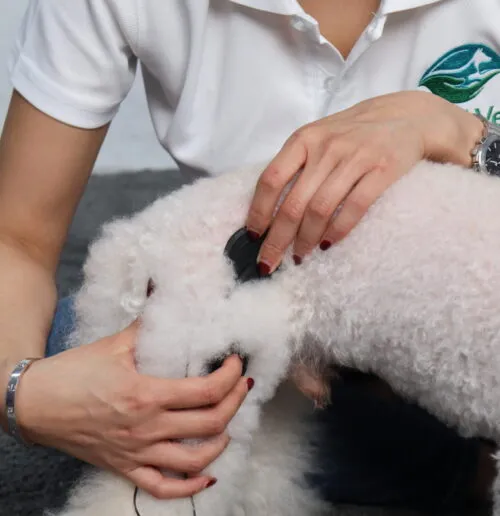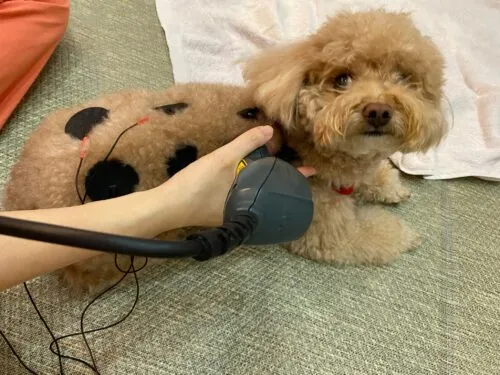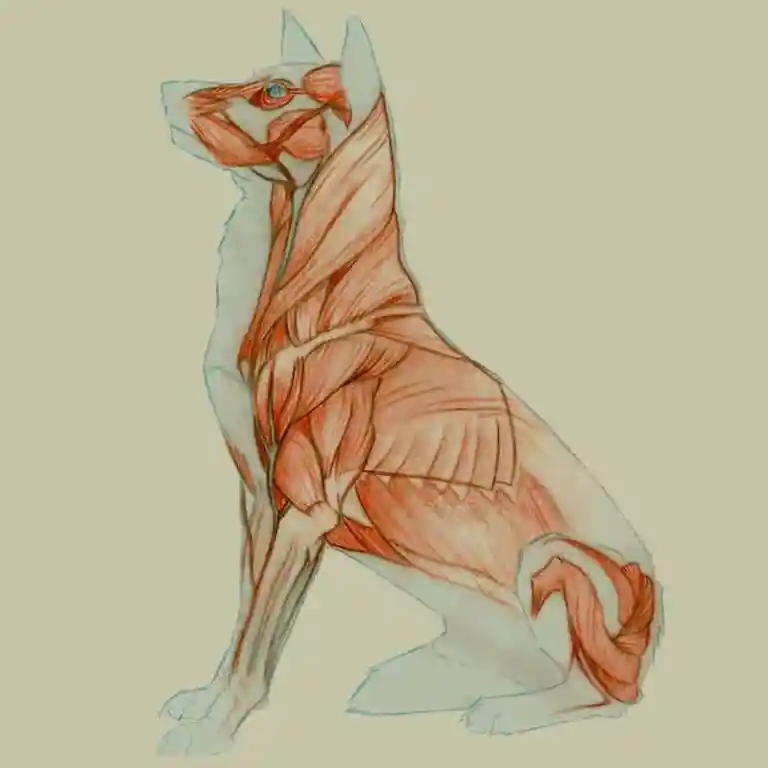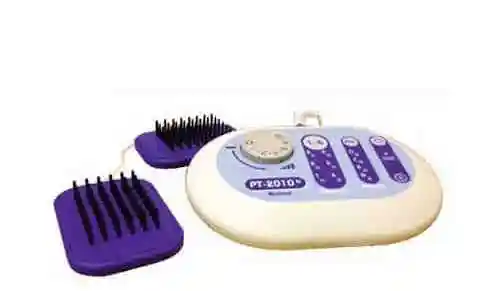NMES (Neuromuscular Electrical Stimulation) and TENS (Transcutaneous Electrical Nerve Stimulation) are therapeutic modalities used for treating animals, offering:
Muscle strengthening: NMES targets muscle contractions to build strength and prevent atrophy in injured or post-operative pets.
Pain relief: TENS provides pain relief by stimulating nerve fibres and blocking pain signals to the brain.
Enhanced recovery: Both NMES and TENS can aid in post-operative and injury rehabilitation, promoting faster healing and improved mobility.
Non-invasive treatment: These therapies are drug-free and non-invasive, offering a safe treatment option for various conditions.
At RehabVet Clinic, we incorporate NMES and TENS therapies to provide comprehensive and effective care for your beloved pets.


NMES (Neuromuscular Electrical Stimulation) and TENS (Transcutaneous Electrical Nerve Stimulation) are therapeutic modalities used for treating animals, offering:
Muscle strengthening: NMES targets muscle contractions to build strength and prevent atrophy in injured or post-operative pets.
Pain relief: TENS provides pain relief by stimulating nerve fibres and blocking pain signals to the brain.
Enhanced recovery: Both NMES and TENS can aid in post-operative and injury rehabilitation, promoting faster healing and improved mobility.
Non-invasive treatment: These therapies are drug-free and non-invasive, offering a safe treatment option for various conditions.
At RehabVet Clinic, we incorporate NMES and TENS therapies to provide comprehensive and effective care for your beloved pets.
Electrical therapy (TENS & NMES) can treat various conditions in dogs and cats, including:
Chronic pain: TENS therapy alleviates pain in pets suffering from conditions such as arthritis, hip dysplasia, and degenerative joint disease.
Post-operative pain: TENS & NMES can help manage pain and promote healing following orthopaedic or soft tissue surgeries.
Muscle atrophy: NMES therapy stimulates muscle contractions to prevent muscle loss and build strength in pets recovering from injury or surgery.
Neuromuscular disorders: Electrical therapy can help restore nerve function and improve muscle control in pets with neuromuscular conditions.
Injury rehabilitation: Both TENS and NMES support recovery from sprains, strains, and tendon injuries by reducing pain and promoting muscle strength.
Spinal cord injuries: Electrical therapy can aid in the rehabilitation of pets with spinal cord injuries by supporting muscle activation and nerve function.


Electrotherapy can be used for wound healing, pain control or relief, reduction of inflammation, muscle re-education, reversal of atrophy and strengthening. This modality works at many levels, affecting both the sensory and motor nerves. At the cellular level, electrotherapy causes nerve cell excitation and changes in cell membrane permeability, therefore stimulating protein synthesis, osteosynthesis and fibroblast formation. At the tissue level, electrotherapy causes skeletal muscle and smooth muscle contraction. At the segmental level, it facilitates muscle-pumping action, resulting in improved joint mobility as well as circulatory and lymphatic drainage.
An application of electrical current through the skin, transcutaneous electrical nerve stimulation (TENS) is used primarily to manage pain. A small, battery-operated TENS unit delivers an electrical current to the patient through electrodes placed directly on the skin. The pulse rate, width and intensity can be adjusted according to treatment objectives. TENS works by stimulating faster sensory nerves with an electrical impulse, causing an overload of interneurons, which limits the ability of sensory nerves to transmit pain signals to the brain, creating analgesia for the patient. The effect of this modality is short-lived, however, as it generally does not last for more than an hour. In veterinary rehabilitation, TENS is used immediately post-operatively and during therapy to help a patient work through a painful treatment.
Stimulating the nerve that causes the muscles to contract, neuromuscular electrical stimulation (NMES) is used to rehabilitate muscles. This method is delivered to the patient via leads and flexible, low-resistance electrodes that conform to the skin. NMES can be used to help prevent muscle atrophy, increase local blood circulation, and maintain or increase joint mobility. It is particularly useful in patients with edema, delayed wound healing, or in those unable to perform voluntary movement.
The NMES unit features many adjustable variables, including intensity, pulse duration, current, frequency, on-off times, ramp duration and treatment duration. Ramp duration — the amount of time from the onset of the current until the full strength is delivered — is particularly important in veterinary rehabilitation. In human physical therapy, the therapist can explain to the patient how the current and contraction will feel. We don’t have this luxury with our patients; therefore, we must provide a slow, gradual onset of contraction strength to alleviate as much discomfort as possible. An NMES treatment generally lasts 15 to 20 minutes and achieves best results when used two to three times a week.
CITATION
Distefano G, Ferrari RJ, Weiss C, Deasy BM, Boninger ML, Fitzgerald GK, et al. (2013)
Cellular therapy is a potential approach to improve the regenerative capacity of damaged or diseased skeletal muscle. However, its clinical use has often been limited by impaired donor cell survival, proliferation and differentiation following transplantation. Additionally, functional improvements after transplantation are all-too-often negligible. Because the host microenvironment plays an important role in the fate of transplanted cells, methods to modulate the microenvironment and guide donor cell behavior are warranted.
The purpose of this study was to investigate whether the use of neuromuscular electrical stimulation (NMES) for 1 or 4 weeks following muscle-derived stem cell (MDSC) transplantation into dystrophic skeletal muscle can modulate the fate of donor cells and enhance their contribution to muscle regeneration and functional improvements. Animals submitted to 4 weeks of NMES after transplantation demonstrated a 2-fold increase in the number of dystrophin+ myofibers as compared to control transplanted muscles. These findings were concomitant with an increased vascularity in the MDSC+NMES group when compared to non-stimulated counterparts.
Additionally, animals subjected to NMES (with or without MDSC transplantation) presented an increased maximal specific tetanic force when compared to controls. Although cell transplantation and/or the use of NMES resulted in no changes in fatigue resistance, the combination of both MDSC transplantation and NMES resulted in a faster recovery from fatigue, when compared to non-injected and non-stimulated counterparts. We conclude that NMES is a viable method to improve MDSC engraftment, enhance dystrophic muscle strength, and, in combination with MDSC transplantation, improve recovery from fatigue. These findings suggest that NMES may be a clinically-relevant adjunct approach for cell transplantation into skeletal muscle.

NMES is used to rehabilitate muscles by stimulating the nerve that causes the muscles to contract. TENS, on the other hand, is used primarily to manage pain by stimulating faster sensory nerves with an electrical impulse.
Animals with certain health conditions, such as heart problems, skin conditions, or those who are pregnant, should not use electrical stimulation. Always consult with a veterinarian.